The Saintmaker Catholic Lifeplanner – a Review
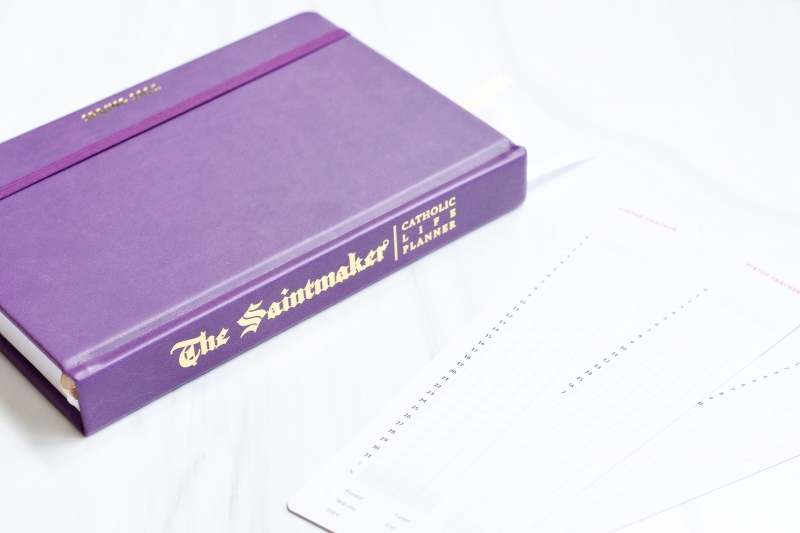
Today, I’m partnering with The Saintmaker Catholic Life Planner to review their brand new planner, which is more of a system. I call it a system because it’s actually a set of 4 (quarterly) books which you can buy one at a time, or as a whole set, and in between the covers you have a planner, goal setting system, journal, spiritual journal, and examen, etc. All in one. Keep that in mind as you read through this review – we’re going to cover a multi-book system – all wrapped up in The Saintmaker Catholic Lifeplanner.
For full disclosure, the team at The Saintmaker reached out to me and asked me to review this planner. They sent me the planner for Spring 2021, and I thank them for sending this planner my way so that I can share my thoughts with you – and because I’ve had a lot of requests from you saying you want to know more about what’s in this planner. Though the planner was sent to me, no other compensation was made, and I am not an affiliate. The thoughts shared are completely my own. I will always let you know when I’m offering my opinion so it doesn’t get tangled up in the actual details/specs of the review.
All photos are my own unless otherwise noted/credited. All photos copyright, 2021, Jen Mackintosh.
Let’s get started – because there is a lotttttttttttttt to look at with this planner!
In a nutshell –
The Saintmaker is a brand new planner on the market. Created by Nathan Meffert, a recent convert (2019) with a background in art, design, technical systems, marketing, creating other planner systems, and a newfound love for the order and rhythm of the liturgical year of the Catholic Church – this planner incorporates a lot more into the pages than you would normally find in a life planner! It is described as a “journal-based life planner” and while it is, it’s really quite a substantial amount more. In the PR materials I received for this planner it is described as a planner that, “takes the user through a step-by-step process of discerning and setting up yearly goals, pursuing them on a seasonal basis,” (as in Church season – not the natural season), “and envisioning an ideal week that will form a structure for living an ambitious, yet Christ-centered, life.”
Mr. Meffert, the creator of The Saintmaker, built this planner with the goal of helping you and I live liturgically – with our Catholic faith in the center of our daily lives – in order to restore authentic Catholic culture. And I think the planner excels in that area! The planner is also designed to help you live Sacramentally, through encouragement of attending the Holy Sacrifice of the Mass as well as prompting space for recording regular examens for Confession and virtue progress with daily reflections that are detailed and spiritual in nature. All in all, it’s a rigorous spiritual and life planning system that I think deserves a detailed look!
I do think the creator hopes this planner will meet anyone, regardless of season of life. And while I do think this planner can be an extraordinary tool in a Catholic’s hands I do think that your season of life is going to come into play with this planner, and it could be a worthy perspective to consider.
My planner perspective –
Now, I feel like I should share my perspective as a planner because I think it impacted my thoughts on this planner quite substantially.
Life is full for me! I’m a Catholic mom of 5. We homeschool all of the kids – 2 have graduated now and I continue to homeschool the youngest 3. I also volunteer a substantial amount of time with my parish (devoted to the Traditional Latin Mass) as an administrative assistant and…let’s just say…a general organizer and helper-wherever-needed! LOL! Annnnnnndddd…I’m a blogger, shop owner, and maintain a presence on Instagram when I’m not also keeping up with those other (more important) things up there. So…yeah. I juggle.
I’m a detail person so a planner is an absolute necessity for me and I thrive with organizational tools! I’m also deeply committed to living our faith in the heart of the home and as an integral part of our daily family culture. I have, over the years, set in place some paper and organizational systems that help me prioritize and steward the gift of time, and I love looking at new tools that speak to those areas! This planner was exciting to review and many (most) of the features are absolutely unique in both the planning and the Catholic community!
Pricing & Availability
The Saintmaker is available year round through the website. You can subscribe for the entire year, or you can purchase a single book with pre-order pricing, or you can purchase a single book with regular pricing (once pre-order is closed).
- Single Planner
- Pre-order price (ends one month before each quarterly start date) $39.99
- Regular price $49.99
- Yearly Subscription (4 planners covering an entire year). The planners do not ship out all together, but rather ship four times/year for delivery by the seasonal start dates of April 1, July 1, October 1, January 1. (This would be difficult for me because I’m future planning quite a bit – placing ACT dates in my planner, or birthdays, or events, or dental appts, etc. So I need my full yearly planner in front of me to get those dated events onto paper so I don’t forget them. It would be nice if the 4 planner system would ship together, but a workaround would be to use your ical or google cal for your future planning and then transfer those events into your Saintmaker Lifeplanner for each quarter. But that involves some duplicating of work so you’ll have to decide if that’s worthwhile for you.)
- Pre-order price $144.00
- Regular price $180.00
Without a doubt, this is the priciest planner system I’ve ever reviewed. I want to be clear – I do think the planner quality and content is high, but I always think of my audience when I write – all of you! And I think of all of you because you’re a lot like me. I’m budgeting and buying shoes for kids who hit growth spurts, and groceries, and class fees, and braces, and car repairs, and saving, and on and on. For many, the pricing tier puts this planner out of our reach if we want a full year of planning in this system, and I do understand that. Having said that, I’m not afraid to invest in a planner!! After all, I consider a planner an investment in my time and my ability to manage my time, and in order to be absolutely fair, one does need to consider that this planner replaces 3 books – your life planner, your goal planning system, and your spiritual journal – and that makes the price more reasonable. Now, if that price up there seals the deal for you, I’d ask you to read through to the end anyway – just so you can be familiar with this planner and its features. (Again, I make nothing if you buy this planner!! I only want you to read on so you can see this planner system fully.)
Structure, layout, features
- The Saintmaker is a 4 book set of hard bound planners. Each planner covers 3 months, or 1 quarter of the year.

- Each of the 4 books has a uniquely colored cover – white, violet, green, red – each to represent the liturgical colors of the season. (My personal preference would have been to have the covers all one uniform color because the liturgical year doesn’t divide itself perfectly across the four quarters of a church year. For example, my spring cover is violet, which represents penitential seasons like Lent, but Lent is only on the first 3 pages of this book and then we move to Easter, and then Pentecost. And also because…I just prefer the exterior of my planner to be a single color – maybe a neutral buff color, or basic black. And then I’d love to see the liturgical colors represented in other ways – like a thin ribbon of color down the outer edge of each page. That allows the accurate liturgical designations to reflect each day and season.)
- Each book comes with 2 satin ribbons for marking your place – helpful!
- This planner has monthly, daily, and weekly pages in each 3 month planner – and that makes this planner thick!! Thus, 4 separate books worth of planners in the year.
- There are yearly and seasonal goal pages in each planner – meaning this planner system covers life planning, spiritual journaling, and goal setting – all in one. If you are someone that needs it allllllll between two covers, this might be a good system for you to consider.
- Each planner comes with three virtue tracker bookmarks (pictured below). The bookmarks are printed on cardstock – with the tracker side non-coated, and the opposite side coated (with a listing of different sins and different virtues). I love the idea of encouraging virtue development, and I love a good tracker! (I understand the point of the bookmark in keeping your virtue progress always front and center, but if I were using this I would probably want this to be a bit more discreet rather than a bookmark poking its head over the cover of my book all the time. I think I’d prefer an accessory that would format this virtue tracker onto a sticky notepad so I could set up my virtue tracker sticky note for the month, put it in my planner, and refer to it – without it falling out of my planner, or being visually at the top of my planner all the time. Also…even if I didn’t use the planner system, I’d absolutely purchase a virtue tracker sticky notepad accessory!)
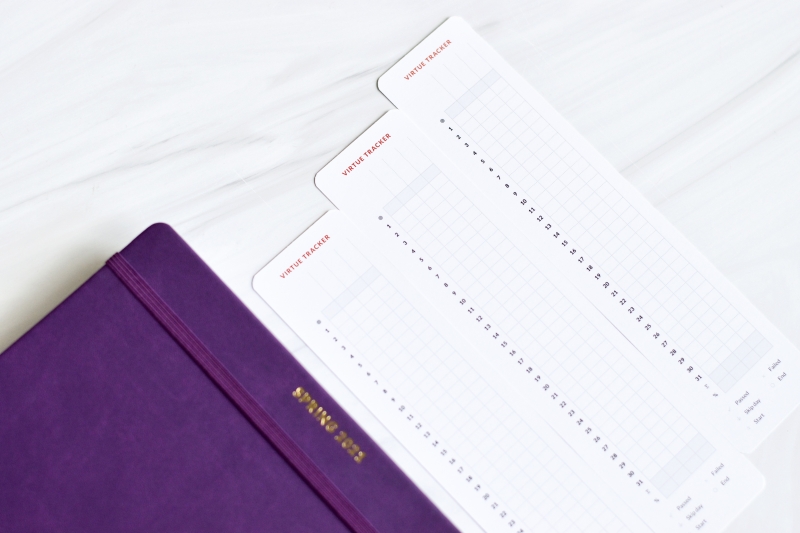
- There are 300 pages in this planner – printed in color. The monthly pages have a variety of colors to help with liturgical designations, but the main pages are grayscale (variations of gray/black) with a little red ink. The font is easy to read and There are a total of 23 unique pages within the covers – which we’re going to walk through down below! Because I have some definite thoughts on these pages!
- The book is hefty at 1.56 lbs, but the cover is a smooth, velvety feeling and it’s a dense package. I had no trouble sliding it in and out of my purse or bag.
- The dimensions: 8.66″ long x 5.75″ wide x 1.125″ tall.
- I wish I knew the paper type and weight to share with you, but it isn’t specified. I can tell you it’s on the thinner side, which makes sense considering the sheer volume of pages in this planner. But the thin pages still did really well with my pen test – which I’ll share with you below. I was pleasantly surprised that there was really no shadowing or ghosting – even with highlighters – in spite of the thin nature of the paper. I did have a little etching on the back side of the page, but full disclosure – I write with a heavy hand. I’m really impressed with paper quality.
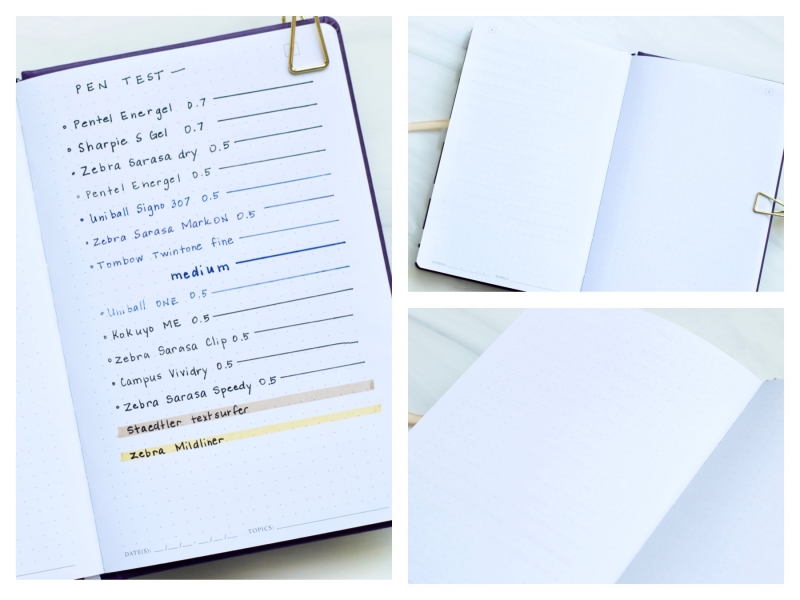
- The planner is a Smyth sewn binding that is supposed to be a lay-flat binding. I have had several flat lay sewn bound planners, so I’m not unfamiliar with manipulating them a little to convince them to lay flat, but I cannot manage to convince this planner to lay flat at all. And you’ll see that in a few pictures because I had to use a clip or a Rosary to hold pages open to take photos. My guess is that the book is too thick overall to lay flat – the best flat lay planners I’ve had were a little thinner and the width of the pages were wider than The Saintmaker’s 5.75″, adding a little extra weight to get the planner to physically separate and open. The best I could do (and I worked with this planner for a couple of weeks, taking photos, etc) was to bend the covers apart several times – stretching the bound edge – and then I could get pages to accordion upward, but never a flat lay. (see below) When using a planner – flat lay is so important to me! My planner usually sits open on my desk (unless it’s in my bag) so I can readily see the day and add and check off – so I wanted to be sure to mention this aspect to you!

- The planner also comes with an attached elastic band for holding the book together – something that I normally find gets in my way when I’m writing in my planner – but the elastic on this planner folded neatly and wasn’t a cause of bumps or odd angles when I was trying to write. I also found I liked to use the elastic to actually mark my place in the planner, rather than using the satin ribbons, because it meant easily opening to my place.

- The back of the planner has an accordion pocket for storing stickers, appointment cards, etc. Speaking of stickers, I probably wouldn’t use too many. The planner is already thick and the addition of stickers would really bulk up this planner so that the covers wouldn’t close. But, I imagine the primary market for this planner uses pen, a highlighter, and an occasional clip – all of which I think would work fine for this planner!
Let’s Walk Through from front to back

The first page is a cover page with The Saintmaker branding and several spaces for you to jot down name, phone, email, address.
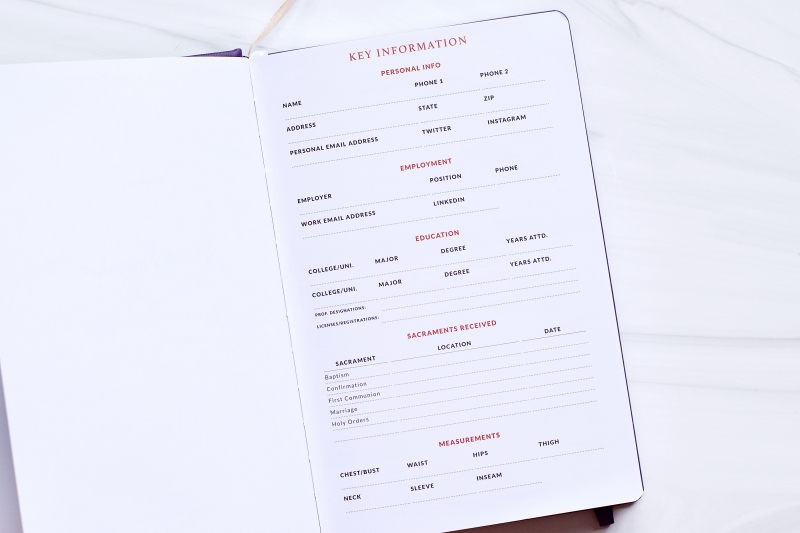
The next page is the Key Information page, and I have some thoughts on this page. Suffice to say, this page contains every identifier short of your blood type – personal info, employment, education, Sacraments, measurements. Now, I’m all for containing big picture information for referral, but a lot of these are things I don’t need to refer to. Like employment status, or my education history and accomplishments, or my instagram handle, or Sacraments received (the exception would be for my kids, but I create a table with all my kids’ names and the Sacraments they have each received, and keep a copy in my missal and our family safe).
And then, logistically, I probably would not fill this same page out four times a year – with each new quarterly planner. And to be honest, I doubt I’d spend the time filling it out even once for one quarterly planner because I know that in three months this planner goes on a shelf. (If I were on the design team for Saintmaker 2.0, this page would be eliminated from the planner, and some iteration of this page would instead be a cardstock insert available as an accessory, and small enough to tuck in the back pocket of the planner. Then it could be moved from planner to planner!! And I’d probably turn this page into a perpetual calendar of sorts – with each of the 12 months listed, and a place to note the birthdays and anniversaries for each month because that would be something I would find truly useful!)
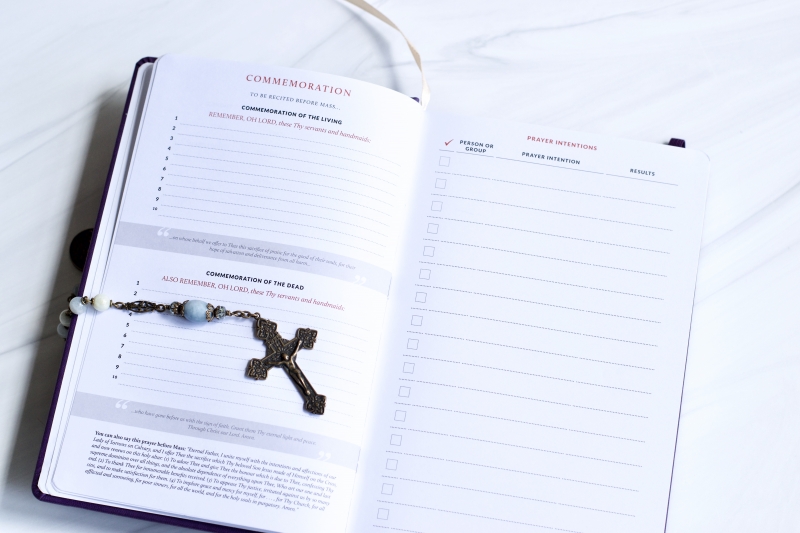
Next up, the Commemoration and Prayer Intentions page. (Note: I had to use my Rosary to hold these pages open because they wouldn’t stay open for me to photograph otherwise.) The Commemorations page is to jot down all of those that are living, and those that are deceased, that you want to remember in your prayers and during the Mass. It’s a lovely page and opposite it is a Prayer Intentions page, which is pretty self-explanatory.

The next page is a dot grid page, signaling that the planner is moving into its goal section because following that is an annual goals page.
About the prep section before the planning pages…
I found the prep section before the actual monthly/weekly/daily planning pages to be a little confusing – not in terms of content, but in arrangement and organization. It’s a group of 14 pages at the beginning of the planner and then the planner just…starts….and then just goes right into the monthly planning pages – there are no tabs or indicators of prep pages, monthly pages, weekly pages, or daily pages – and it took me several times of flipping through and reading over the pages to finally see that there are prep pages, and then there are planning pages.
(I would have loved some small inset tabs (stretch/widen the covers so the tabs are inset inside the covers) or notch the pages in a graduated way from prep pages at the beginning all the way through each of the three months (You’d end up with 4 main graduated, notched sections). This would have a double function of helping you to navigate the planner and would also indicate where the planner starts, and the prep pages end. Because I definitely would have liked a tab or some other kind of grouping of like pages in this front section so that I could easily refer back to these sections – which frame your quarter, and thus inform your planning.)
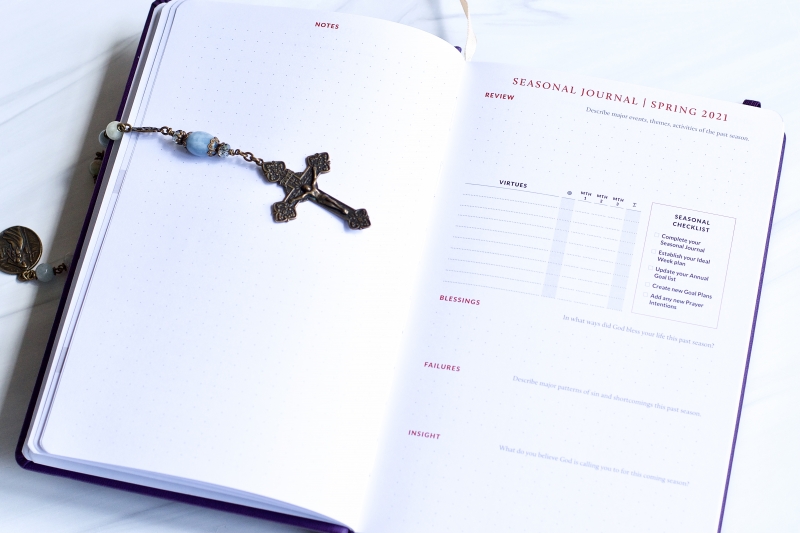
The next of the goal setting pages include another dot grid page and a seasonal journal to reflect the particular quarterly book you’re in – for this review, I have the Spring 2021 book. This page is a big picture of what’s upcoming, the virtues you want to target this quarter (these would correspond with your virtue tracker bookmarks), and a reflection of your blessings, failures, and insights for the coming season. Now, I’m a lover of details because I’m a really type A person…but plan with your temperament in mind, especially if these type of deep reflection pages cause circular negative thoughts or scrupulosity!
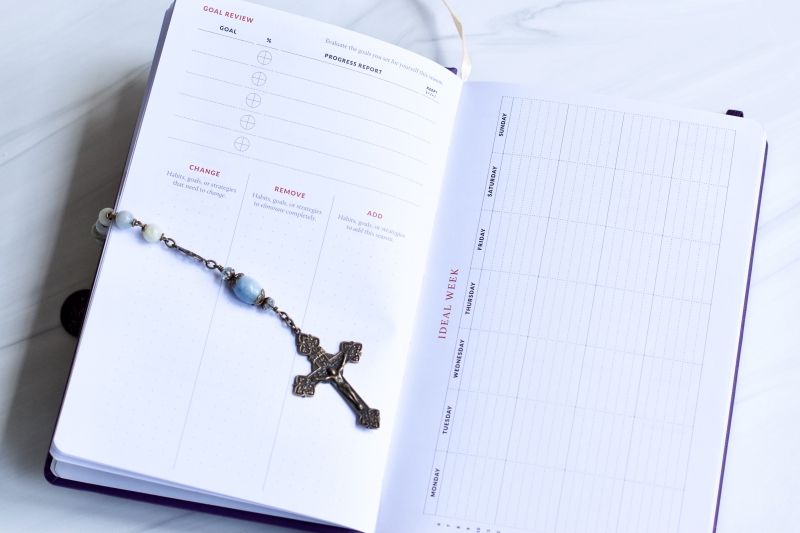
Continuing with the goals section, we come to the next two pages which contain a goal review page and then, one of my absolute favorite pages in this planner – a map of an ideal week!
None of us have days or weeks that roll according to plan…and that’s not because we’re planner failures, but because…that’s life! And that’s God’s plan! Your plan may have been to accomplish 42 bazillion hours of productive homeschool and have a pristine house, but God’s plan may be that you shift gears to meet a sick child, parent, or a spouse’s needs. It is so much easier to shift and gently return to normal routines – especially after a season of crisis or suffering – if you have a picture of an ideal week.
This reminds me of the rule of St. Benedict which provides structure and order to a monk’s day. The ideal week allows for a picture of your own rule, with allowances for your vocation. It’s the goal. I love that this comes at the beginning of each season, because ideal weeks can and should change with the seasons of your life! (I was thinking how amazing it would be if this page were turned into a notepad that was available as an accessory, or even a free printable on The Saintmaker site so that anyone – even those that are not using this planner system – can benefit from prayerfully considering what an ideal week looks like for his/her current season of life.)
If I used this planner, I’d probably add a sticky tab right here so I could flip back with ease to my goal review section as well as my ideal week!
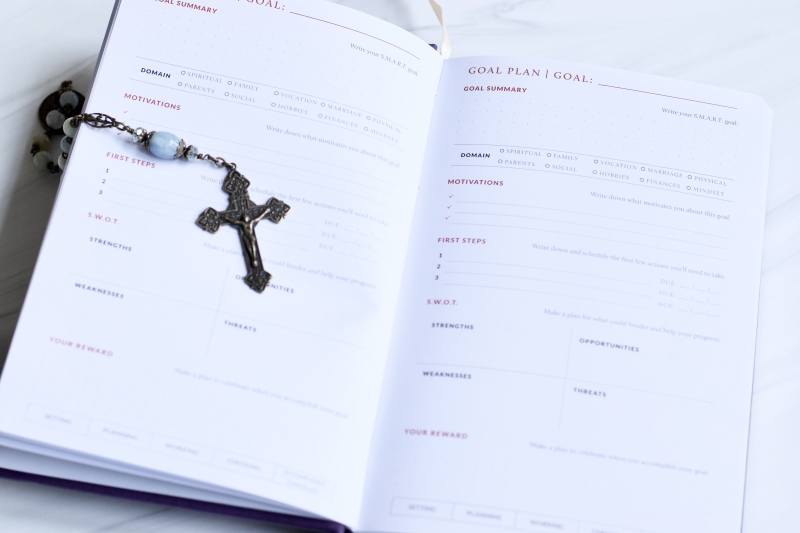
Wrapping up this entire goal section, there are a total of 5 Goal Plan pages for individual goals for each quarter. This is a great page for detailing out an individual goal and of course, my favorite part of the page is writing down that reward at the bottom of the page! I’m a huge fan of setting small rewards for tasks and accomplishments – especially those that I tend to consistently put off!
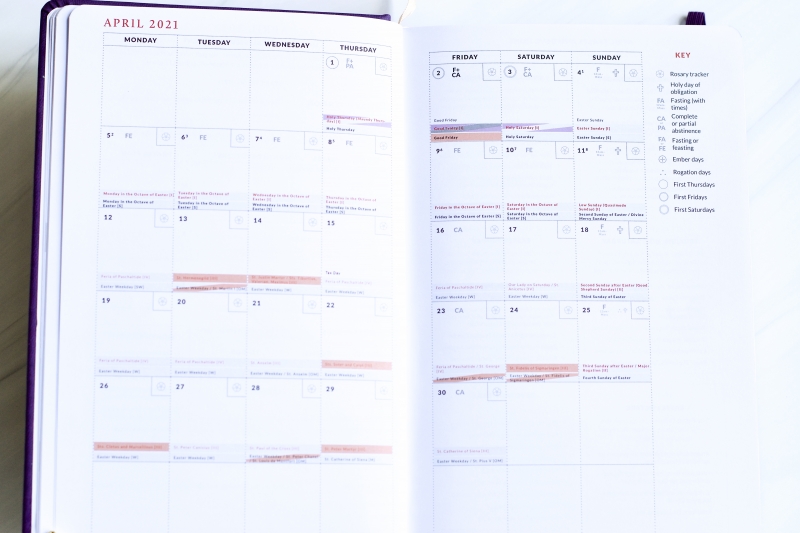
Turn the page and you’re in April (or whatever month your planner starts with). This page may look intimidating at first because of the different colors and the symbols so let’s try to break things down.
This is a Monday start calendar. This seems to be a popular shift among planner companies now, but I have to tell you that it messes with my head. I’ve been a Sunday start planner girl for so long that more than once I mis-read events I had listed on a Monday start calendar and dropped a ball – enough so that I’m wary of using them now. I know they are popular with many, and I see some practical value in grouping the weekend together, but I prefer Sunday starts, and if you do too, I thought the Monday start worth mentioning.
The 2 Liturgical Calendars. One of the reasons I agreed to review this Catholic planner in the first place (actually, the primary reason) is that it includes the 1962 calendar. As a Catholic, faithful to the Magisterium of the Church, and a planner – I want to see the 1962 dates – the Ember Days, the Rogation days, Ascension Thursday on a Thursday, etc. This planner includes both the 1962 calendar of the Traditional Form, and the Novus Ordo calendar of Paul VI, 1969. In this planner, and looking at an individual calendar date block, the 1962 calendar is the top calendar designation, and the bottom calendar designation in each block is indicative of the 1969/Novus Ordo. I couldn’t find an explanation of that anywhere, so if you’re new to the liturgical calendar, that might be confusing.
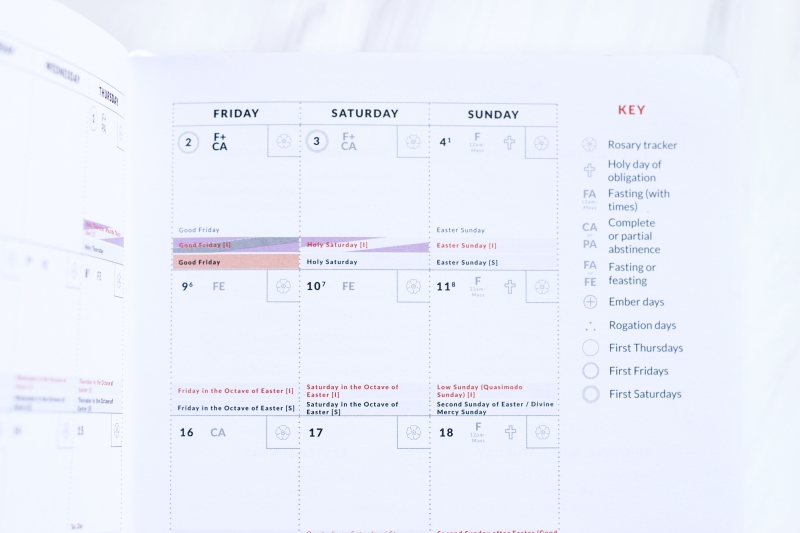
The colors in the calendar. I couldn’t find an explanation of the use of the liturgical colors, the stripes in some colors, and the different color text, nor what the parenthetical symbols mean. I think these should have been indicated with the other symbols in the key to the right of the calendar. I believe the highlighted colors indicated the liturgical color of the day, which designate the Feast of the day (for example, a martyr’s Feast would always be red to indicate that the martyr shed his/her blood for the Church). When we see a stripe in the highlighted color, such as on Holy Saturday in the Traditional/1962 calendar, that means that the color of the day changes. For example, on Holy Saturday, the color is still violet to indicate the somber, penitential nature of the final day of the Holy Triduum, but once the Easter Vigil takes place (after sundown), the color changes to white for Easter. Again, these explanations should be a part of the key. Also, I’m pretty sure the coral/peachy color is just a variation of red.
The rest of the symbols are explained well in the key section of the calendar page.
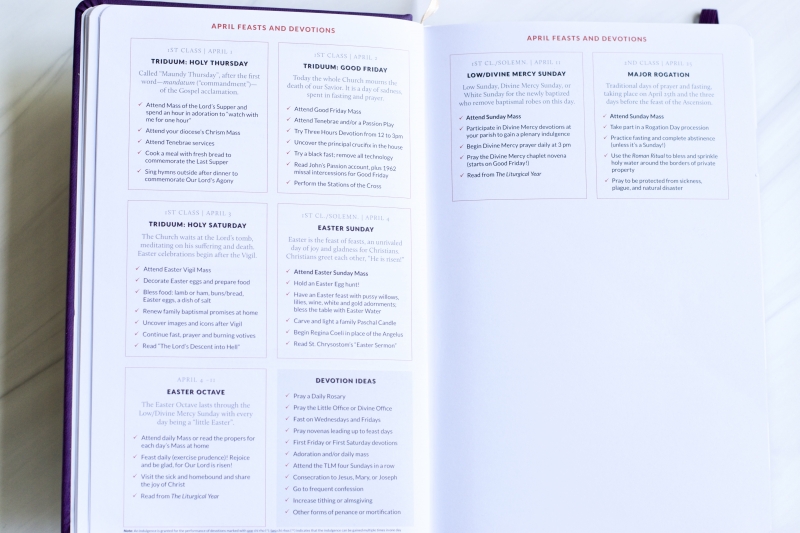
Behind every month is a 2 page spread of that month’s Feasts and Devotions. Finding this page was like hitting gold!! I’ve never seen anything as succinct (this fits on 2 pages!!!) yet informative with traditional devotional ideas for the big feasts of the month! An absolute treasure! (Again, I’d absolutely love and beg to see the 12 monthly feasts and devotions pages available as an accessory for purchase – independent of the planner. I’d be first in line to purchase!! I’d purchase these pages and punch them to fit in my own planner, and I’d love to purchase the calendar pages as well!)
The designation of the Feast Day (1st Class, Solemnity, etc) and the date(s) is first, below that the name of the Feast is in bold, then a simple explanation of the Feast is below the name, and finally….simple recommendations for highlighting and living the particular Feast! My favorite thing is that attending Mass is always the first on the list because it is the par excellance for living the liturgical year! But the other devotional ideas are brilliant and all completely doable!!! Most of them are prayer devotionals, some are home focused, but they all point beautifully to the Feast! I really can’t say enough about the monthly feasts and devotions page – except to say that it stands alone as a wonderful resource and I hope it can be available to purchase as a stand alone one day!
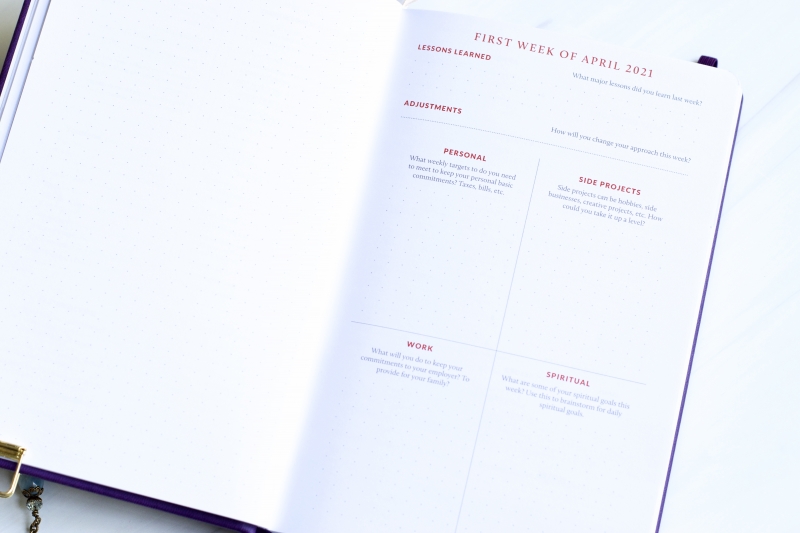
Following each of the monthly feasts and devotions page is a dot grid page – useful for listing out your monthly Mass schedule, or monthly priorities. Next to it is the First Week of the Month page. There are 4-5 of these for each week of each month – first week of the month, second week of the month, third week, and so on. This is your weekly page, and it’s really more of an overview-of-the-week kind of page with places for reflecting/journaling, as well as places for listing tasks for the week. It might be hard to tell in my photo, but those are dot grids in each box on the weekly page.
Behind each weekly page are 7 daily page spreads and here’s where we start getting into the daily detailed journaling and reflecting…
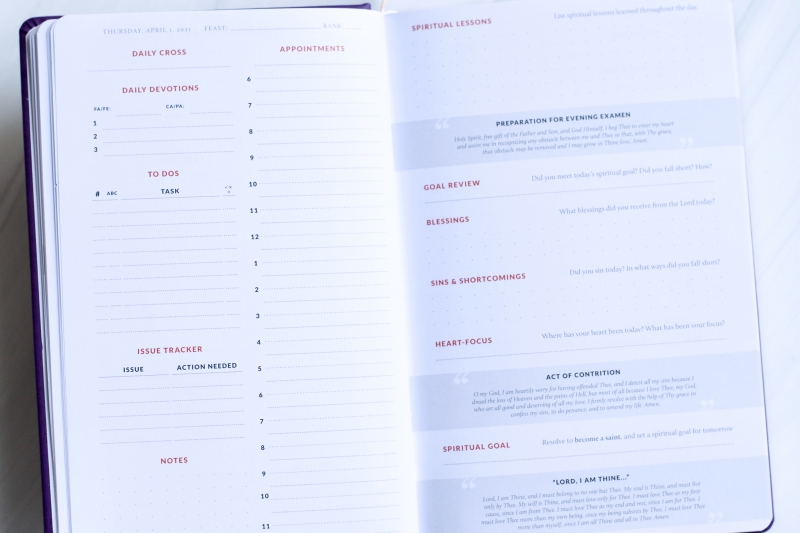
I’ll let you look over these two pages for a minute because there is A LOT here! Two pages for every single day!
This planner is a dated planner so the date is at the top of the page, along with space for listing the Feast (and the Feast’s Rank) for every day. There is place to list your daily cross, daily devotions, To Dos, an Issue Tracker (?? would that be like, “out of ice cream” – action needed: “send someone to store asap!”????), and a small notes section and then a timed column (with half hour lines) that starts at 6 am and goes to 11 pm for your daily schedule. That’s a pretty highly detailed daily page, but remember, it is only one of two pages for your day.
The second daily page is focused on your spiritual needs, goals and prayers, and functions as your daily journal page with space for journaling spiritual lessons, a goal review, blessings, sins and shortcomings, your heart-focus, an Act of Contrition, your spiritual goal for the day, followed by a prayer. The page is set up for you to journal in the evening, but I think you could also do your journaling in the morning as a reflection (if that’s more your journaling style!).
(I have to say, I’d probably avoid at least a portion of this journaling page. Because…discretion. I’m a mom and my planner is in the middle of every part of my day. My kids flip through my planner to see when the orthodontist appointment is, when my son is serving Mass next, and Dad’s days off. So, having spiritual lessons and daily sins and shortcomings listed alongside my to-do list and the daily appointments pretty much blows discretion! I know this is a consequence of having your planner integrated with your journal, and if you are a single person, or even a mom of non-reading kids (LOL!) maybe you wouldn’t mind bearing your soul on these pages, but for me it’s just too much sharing in my planner.)
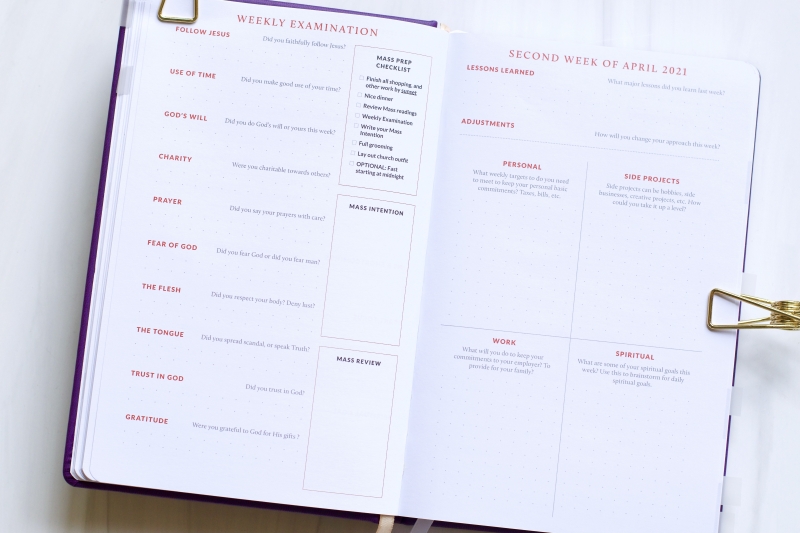
The end of each week has a weekly examination page which has prompts for common sins (and again, I wouldn’t use this page because these are personal and private – between myself, my confessor, and God.) But if you could use a jump start with a weekly examen this page could be helpful. The Mass prep checklist is nice for a reminder, and I love the idea of setting your Mass intention the night before. I assume the Mass review is for notes, but I’m not entirely sure the purpose of that small section. And then, we start with the next Weekly overview page.
This repeats through the entire quarterly planner.
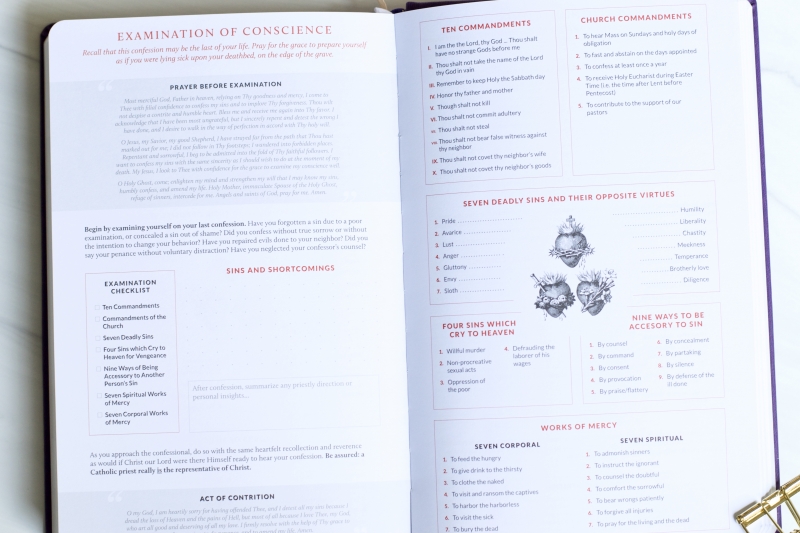
After 3 months of planning the back of the book has more Examination pages. (I assume you have the idea by now that I wouldn’t use these pages because they are not discreet if they’re in my planner, so I’m not going to repeat it anymore.)
The Examination of Conscience page is set up to help you examine before a confession. It has space for listing sins you plan to confess as well as a place to note the priest’s direction. The opposite page has helpful lists of the Ten Commandments, The Church Commandments, and other things to keep in mind as you examine your conscience. There are a total of 5 sets of these Examination of Conscience 2-page-spreads. And then…there is one final Examination of Conscience page but opposite it is a lined Personal Journal Index page instead of the boxed page of examen helps.

Following the Examen pages are 38 dot grid pages, each with a place for noting date and topics for that page. And then the back pocket and end of the planner.
And that’s it for one quarterly book of The Saintmaker LIfeplanner! It’s a lot, I know! There are a lot of thoughtful design and resource items in this planner!
In summary
This is a thoughtful Catholic planner and spiritual journal and examen, but I’d be sure to include the word examen in the descriptor. There are some great planning tools in here with the detailed liturgical year monthly pages, the Feasts and Devotions pages, and the goal setting with a view toward virtue. I, personally, would like to have the option of having some of these really wonderful pages available to purchase as a stand alone to integrate into my own planning system! And as much as I love the idea of an integrated spiritual journal and planner, I’m never going to list my sins and shortcomings on a page next to my grocery list, but it might be a great fit for you and your season of life!
I’d love to hear your thoughts on this planner! Are you excited to see all of this detail in between two covers? Would you love an integrated planner and Catholic journaling system? Share your thoughts below!






Thank you so much for your in-depth review on this planner! I had been waiting for you to do this ever since you shared it on IG. I agree with you on all accounts especially with writing down shortcomings/sins, but I was thinking you could get one of those privacy stamps and use it to “erase” those thoughts after having confessed them. I love that the traditional calendar is included as well as the NO calendar because it’s nice to see the differences and similarities within the two calendars. I also agree with you in that I personally would like a more neutral color base for the covers versus such bright and vibrant colors. I understand the logic behind the colors, but aesthetically speaking, tans/brows/grays would just fit in better with my tastes. Other than that, I think it’s a great planner, and I’m strongly considering purchasing one!
I am older, and the thought of writing in such a tiny booklet is the main obstacle to my purchase of these planners. That said, I cannot imagine the cost, if they made them bigger.
Thank you for your careful, in depth review. I do not find this planner at all practical (in my view a planner and a journal is not a good mix) and it’s very expensive for what it is. Yours is the first review I have seen that reviews this book objectively. Thank you. I will stick to the one I have!
Thank you so much for your comprehensive review of this intriguing planner — such an integrated approach seems like a dream, honestly. At the same time so many of your points about its functionality ring true for me. I do sincerely appreciate your thoughtful, honest review — I think I can make a truly informed decision now.
I really appreciate the detail of the review. I love planners, blank books, pens, breviaries, antique missals and prayer books, and I’m quite familiar with all the Catholic complexities (1962, 1969) and even Rule of St. Benedict. And I love the Saintmaker concept, but my foray in the fall quarter was a bit overwhelming. I can see where drifting into scrupulosity for some people could be a problem, but even taking a non-OCD approach seems like a serious investment in time. I am glad you mentioned St. Benedict: I found using the monastic schedule (Terce, Sext, None) helped with mapping the “Ideal Day” because they impose nice 3-hour segments. Now I’m staring at the white binding and blank pages of the new book and trying not to hyperventilate…
Thanks for sharing I bought the planner and love the setup got the pens they suggested. Would love to hear how you set up your planner. Thanks
I might be interested if it contained the missal of 1952. In this novus ordo format, I find it neither spiritually enriching nor affordable